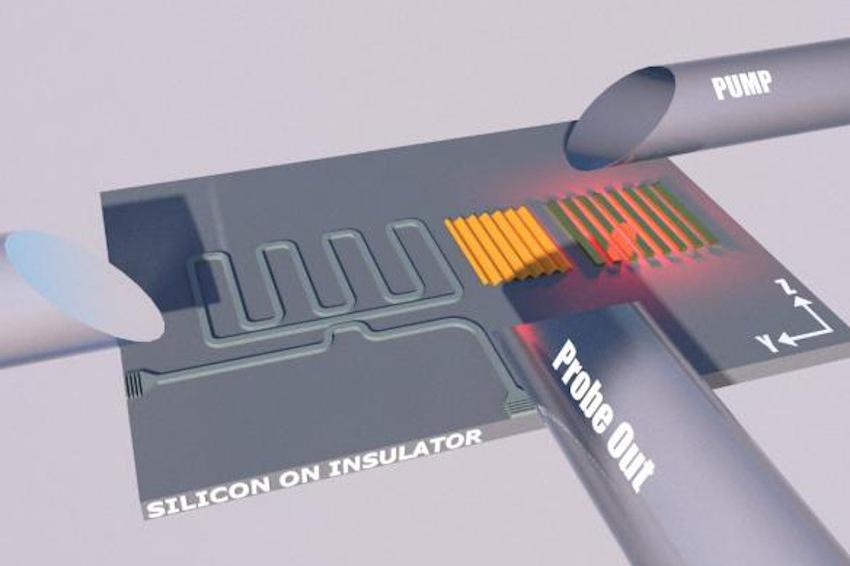Silicon chips combine light and ultrasound
31.05.2021 - Long delays and narrow filtering of microwave signals in silicon-photonic circuits.
The continued growth of wireless and cellular data traffic relies heavily on light waves. Microwave photonics is the field of technology that is dedicated to the distribution and processing of electrical information signals using optical means. Compared with traditional solutions based on electronics alone, microwave photonic systems can handle massive amounts of data. Therefore, microwave photonics has become increasingly important as part of 5G cellular networks and beyond. A primary task of microwave photonics is the realization of narrowband filters: the selection of specific data, at specific frequencies, out of immense volumes that are carried over light.
Many microwave photonic systems are built of discrete, separate components and long optical fiber paths. However, the cost, size, power consumption and production volume requirements of advanced networks call for a new generation of microwave photonic systems that are realized on a chip. Integrated microwave photonic filters, particularly in silicon, are highly sought after. There is, however, a fundamental challenge: Narrowband filters require that signals are delayed for comparatively long durations as part of their processing. “Since the speed of light is so fast,” says Avi Zadok from Bar-Ilan University, “we run out of chip space before the necessary delays are accommodated. The required delays may reach over 100 nanoseconds. Such delays may appear to be short considering daily experience, however the optical paths that support them are over ten meters long! We cannot possibly fit such long paths as part of a silicon chip. Even if we could somehow fold over that many meters in a certain layout, the extent of optical power losses to go along with it would be prohibitive.”
These long delays require a different type of wave, one that travels much more slowly. In their study, Zadok and his team from the Faculty of Engineering and Institute of Nanotechnology and Advanced Materials at Bar-Ilan University, and collaborators from the Hebrew University of Jerusalem and Tower Semiconductors, suggest a solution. They brought together light and ultrasonic waves to realize ultra-narrow filters of microwave signals, in silicon integrated circuits. The concept allows large freedom for filters design. Bar-Ilan University doctoral student Moshe Katzman explains: “We've learned how to convert the information of interest from the form of light waves to ultrasonic, surface acoustic waves, and then back to optics. The surface acoustic waves travel at a speed that is 100,000 slower. We can accommodate the delays that we need as part of our silicon chip, within less than a millimeter, and with losses that are very reasonable.”
Acoustic waves have served for the processing of information for sixty years, however their chip-level integration alongside light waves has proven tricky. Moshe Katzman continues: “Over the last decade we have seen landmark demonstrations of how light and ultrasound waves can be brought together on a chip device, to make up excellent microwave photonic filters. However, the platforms used were more specialized. Part of the appeal of the solution is in its simplicity. The fabrication of devices is based on routine protocols of silicon waveguides. We are not doing anything fancy here.” The realized filters are very narrowband: the spectral width of the filters passbands is only 5 MHz.
In order to realize narrowband filters, the information-carrying surface acoustic waves is imprinted upon the output light wave multiple times. Doctoral student Maayan Priel says: “The acoustic signal crosses the light path up to 12 times, depending on choice of layout. Each such event imprints a replica of our signal of interest on the optical wave. Due to the slow acoustic speed, these events are separated by long delays. Their overall summation is what makes the filters work.” As part of their research, the team reports complete control over each replica, towards the realization of arbitrary filter responses. Maayan Priel concludes: “The freedom to design the response of the filters is making the most out of the integrated, microwave-photonic platform.” (Source: Bar Ilan U.)
Link: Institute for Nano-Technology and Advanced Materials, Bar-Ilan University, Ramat-Gan, Israel







